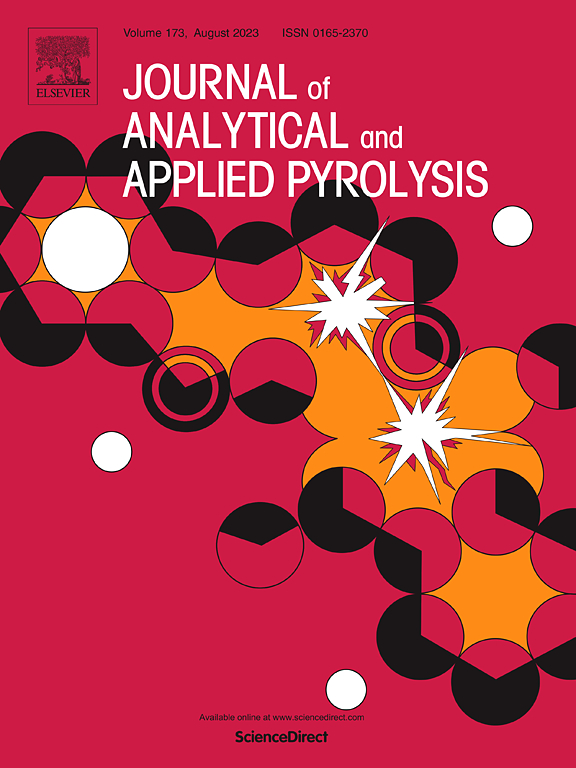石油污染岸线沉积物与有害大型藻类共热解:协同资源回收与技术经济分析
IF 5.8
2区 化学
Q1 CHEMISTRY, ANALYTICAL
引用次数: 0
摘要
由于近岸石油泄漏,石油污染的海岸线沉积物(OCSS)和物种的清理一直是一个挑战。本研究对OCSS和浒苔(Enteromorpha prolifera, EP)的共热解处理进行了研究,以实现资源协同回收。考察了不同OCSS:EP比和温度下共热解处理对石油烃脱除和资源回收的影响,并对共热解产物进行了表征,探讨了协同机理。当处理温度为>; 400℃时,热解固体中石油烃的浓度显著低于相关土壤污染标准。产率结果表明,低温(350 ~ 400℃)共热解对热解油产率具有显著的协同效应。在OCSS:EP = 1:1 (OE11)和400℃条件下,热解油的最佳收率为22.68 %,比理论值提高了5.19 %。动力学分析表明,共热解将最佳反应温度从450℃降低到400℃。产物表征结果表明,OE11热解油的含氧化合物(醛类、酮类、酚类)和C/H比显著降低,较高热值为31.14 MJ/kg。概率技术经济分析表明,共热解处理获得正净现值(NPV)的概率为90.4 %,平均10年净现值为22,756,047元,而常规填埋处理的净现值为负。本研究提出了一种可持续的资源回收方法,用于海岸线清理中油污染沉积物和物种的共同处理。本文章由计算机程序翻译,如有差异,请以英文原文为准。

Co-pyrolysis of oil-contaminated shoreline sediment with harmful macroalgae: Synergistic resource recovery and techno-economic analysis
The cleanup of oil-contaminated shoreline sediment (OCSS) and species due to nearshore oil spills has been a challenge. This study investigated the co-pyrolysis treatment of OCSS and Enteromorpha prolifera (EP) for synergistic resource recovery. The effects of co-pyrolysis treatment at different OCSS:EP ratios and temperature on the removal of petroleum hydrocarbons and resource recovery were investigated, and the co-pyrolysis products were characterized to explore the synergistic mechanism. The concentrations of petroleum hydrocarbons in the pyrolysis solids were significantly lower than the relevant soil pollution standard when the treatment temperature was > 400 ℃. The product yield results show that co-pyrolysis at low temperatures (350–400 ℃) had a significant synergistic effect on the pyrolysis oil yield. The optimal pyrolysis oil yield of 22.68 % was achieved at OCSS:EP = 1:1 (OE11) and 400 ℃, increased by 5.19 % compared with the theoretical value. Kinetic analysis shows that the co-pyrolysis lowered the optimal reaction temperature from 450°C to 400°C. The product characterization results indicate that the oxygenated compounds (aldehydes, ketones, phenols) and C/H ratio of the OE11 pyrolysis oil were significantly reduced, leading to an increased higher heating value of 31.14 MJ/kg. The probabilistic techno-economic analysis shows that the co-pyrolysis treatment had a 90.4 % probability of obtaining a positive net present value (NPV), with an average value of 22,756,047 CNY over 10 years, whereas conventional landfilling treatments resulted in negative NPVs. This study presents a sustainable resource recovery approach for the co-treatment of oil-contaminated sediments and species in shoreline cleanup.
求助全文
通过发布文献求助,成功后即可免费获取论文全文。
去求助
来源期刊
CiteScore
9.10
自引率
11.70%
发文量
340
审稿时长
44 days
期刊介绍:
The Journal of Analytical and Applied Pyrolysis (JAAP) is devoted to the publication of papers dealing with innovative applications of pyrolysis processes, the characterization of products related to pyrolysis reactions, and investigations of reaction mechanism. To be considered by JAAP, a manuscript should present significant progress in these topics. The novelty must be satisfactorily argued in the cover letter. A manuscript with a cover letter to the editor not addressing the novelty is likely to be rejected without review.

 求助内容:
求助内容: 应助结果提醒方式:
应助结果提醒方式:


